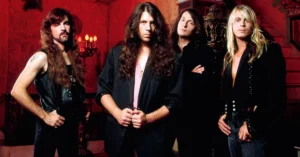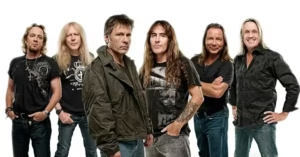Queensrÿche: Visionaries of Progressive Metal Theater
Queensrÿche. Formation and Origins
Queensrÿche was formed in Bellevue, Washington, in 1982, initially as a covers band named The Mob. Their lineup solidified around a shared interest in British heavy metal (Iron Maiden, Judas Priest) and more complex, thematic songwriting.
Queensrÿche. Classic lineup:
- Geoff Tate – Vocals
- Chris DeGarmo – Guitar
- Michael Wilton – Guitar
- Eddie Jackson – Bass
- Scott Rockenfield – Drums
They soon rebranded as Queensrÿche (adding the umlaut for dramatic effect) and released their self-titled EP in 1983, immediately gaining attention for Tate’s operatic voice, the band’s clean, intricate riffs, and their sci-fi aesthetics.
Queensrÿche. Early Releases and Rising Fame (1983–1987)
✦ Queensrÿche (EP, 1983)
- Tracks like “Queen of the Reich” and “The Lady Wore Black” announced their technical proficiency and dramatic flair.
- They opened for Dio and Quiet Riot, building a loyal following.
✦ The Warning (1984)
- A politically tinged, epic-leaning debut LP
- “Take Hold of the Flame” and “En Force” showcased Tate’s range and cinematic production
✦ Rage for Order (1986)
- Marked a shift toward synth-enhanced soundscapes and cyberpunk themes
- Songs like “Walk in the Shadows” and “I Dream in Infrared” blended cold futurism with emotional intensity
- Ahead of its time — often cited as an influence on both prog metal and goth metal bands
Queensrÿche. Artistic and Commercial Peak: Operation: Mindcrime and Empire
✦ Operation: Mindcrime (1988)
- A concept album masterpiece, telling the story of Nikki, a brainwashed revolutionary, and Sister Mary, a former prostitute turned nun
- Lyrically dense, politically charged, and emotionally rich
- Tracks like “Revolution Calling,” “Eyes of a Stranger,” and “I Don’t Believe in Love” became iconic
Regarded as one of the greatest concept albums in metal history, often compared to The Wall or 2112.
- Featured narrative interludes, character development, and Tate’s theatrical delivery
✦ Empire (1990)
- A massive commercial success, more polished and radio-friendly
- Featured “Silent Lucidity” – a Pink Floyd-esque ballad that became a Top 10 hit and earned Grammy nominations
- Other hits: “Jet City Woman,” “Another Rainy Night,” “Empire”
- Sold 3+ million copies and launched the band into mainstream rock fame
Queensrÿche. Decline and Experimentation (1994–2005)
✦ Promised Land (1994)
- Darker and more introspective; themes of fame, identity, and disillusionment
- “I Am I,” “Bridge,” “Out of Mind”
- Critically respected but commercially modest
✦ Hear in the Now Frontier (1997)
- A turn toward grunge-influenced, stripped-down rock
- Divided fans and led to guitarist Chris DeGarmo’s departure — a blow to the band’s creative chemistry
✦ Q2K (1999), Tribe (2003), Operation: Mindcrime II (2006)
- Continued without DeGarmo, with varying success
- Mindcrime II tried to recapture past glory with a direct sequel, featuring Ronnie James Dio as Dr. X (pre-recorded before his death)
Turmoil and Lineup Changes (2007–2012)
- Internal tensions escalated, culminating in a high-profile split with Geoff Tate in 2012
- Legal battles ensued over the use of the Queensrÿche name, with two touring versions of the band at one point
- Eventually, the name was awarded to the version led by Michael Wilton, Eddie Jackson, and Scott Rockenfield
Tate went on to form Operation: Mindcrime, continuing in a more theatrical and conceptual vein.
New Era with Todd La Torre (2013–Present)
With Todd La Torre (formerly of Crimson Glory) taking over vocals in 2012, the band returned to their roots in progressive heavy metal.
✦ Queensrÿche (2013)
- A critically acclaimed reboot, praised for recapturing classic energy
- Songs like “Where Dreams Go to Die” and “Fallout” honored their legacy
✦ Condition Hüman (2015), The Verdict (2019)
- Continued revival with heavy riffs, dynamic songwriting, and modern polish
- La Torre even performed drums on The Verdict after Rockenfield’s departure
✦ Digital Noise Alliance (2022)
- A refined, mature album that blends classic Queensrÿche sounds with fresh production
- Tracks like “In Extremis” and “Behind the Walls” explore mortality, power, and introspection
Musical Style and Identity
Queensrÿche blends:
- Progressive metal complexity (unusual time signatures, concept albums)
- Power metal clarity (soaring vocals, tight arrangements)
- Alternative rock and synth textures (especially in their ’80s output)
They are best known for:
- Geoff Tate’s dramatic tenor vocals (comparable to Bruce Dickinson, Ronnie James Dio)
- Lyrical themes of sociopolitical unrest, technology, war, personal turmoil
- A legacy of musical intelligence and emotional depth
Legacy and Influence
Queensrÿche is known for:
- Being among the first true progressive metal bands, predating Dream Theater and Symphony X
- Combining narrative and melody with metal power
- Elevating concept albums within the metal sphere
Accolades:
- Over 20 million records sold worldwide
- Multiple Grammy nominations
- Operation: Mindcrime and Empire frequently appear on greatest metal albums lists
- Influenced bands like Fates Warning, Dream Theater, Kamelot, Seventh Wonder, and modern prog-metal
Interesting Facts
- Geoff Tate was once offered the chance to audition for Judas Priest
- Their song “Silent Lucidity” was inspired by lucid dreaming and sleep science
- Chris DeGarmo left the band to become a commercial airline pilot, but returned briefly in the early 2000s
- Their 1991 Operation: Livecrime video release was one of the first full-concert concept album performances on VHS/DVD





